THERIANTHOPY TIMELINE
1992: alt.horror.werewolves (AHWW) was founded on Usenet for werewolf fans; White Wolf role-play game, Werewolf the Apocalypse, was released.
1993: alt.fan.dragon was founded for dragon fans.
1994: The first version of the AHWW FAQ was produced; the first meetup or “Howl,” was held in Ohio, U.S.
1995: The revised AHWW FAQ used the phrase “Spiritual Therianthropy.”
1996: The Shapeshifter and Werewolf Handbook or Codex was written by Yaiolani; alt.lifestyle.furry newsgroup was founded for furries; an AHWW shirt was printed with an illustration by Jakkal; the first EuroHowl was held in Wales, an Internet Relay Chat channel opened for Therians.
1997: AHWW’s “Winter of Discontent” caused users to move to other websites; werewolf ‘zine Fang, Claw & Steel was founded.
1998: Roy Wilkinson’s Are You A Unicorn? unicorn site was published. Always Believe went live.
1999: Werenet was founded as an alternative to AHWW.
2000s: There was a proliferation of Therianthropy themed collaborative, informational, and personal sites (e.g. on LiveJournal); other-than-human characters were portrayed in popular culture (e.g. the Sookie Stackhouse franchise/ True Blood ).
2000: Shifters.org was founded, hosting Therianthropy essays and Awereness forum; DragonCon brought together other-than-human identifying people; Rosalyn Greene published The Magic of Shapeshifting.
2001: Werelist was founded, becoming a major Therianthropy forum; Otherkin was interviewed for article in The Village Voice.
2003: The theta-delta symbol was designed to represent Therianthropy.
2006: Lupa published Fang and Fur, Blood and Bone.
2007: Lupa published A Field Guide to Otherkin.
2008: Therians were featured in the documentary Weird True and Freaky: Humanimals.
2010: Orion Scribner began to chart the history of the Therian and Otherkin communities.
2013: The first in-depth academic treatments of Therianthropy appeared in an article by Venetia Robertson and in Danielle Kirby’s book Fantasy and Belief. The Documentary, I Think I’m An Animal, was made about Therianthropy.
FOUNDER/GROUP HISTORY
Therianthropes or Therians are humans who identify as nonhuman animals. Their “animal side” (or “sides” if there are multiple) is commonly referred to as a “therioside” or “theriotype” and can be any kind of animal or species, real, endangered, invented, or 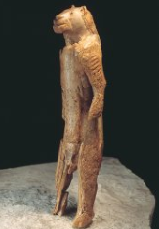 mythical. The term “Therianthropy” is used to describe both this ontological position and the community of individuals who experience it. The word “therianthrope” combines the Greek for “beast” (therion) and “human” (anthropos), and it is classically used to describe such hybrids as depicted in prehistoric art and ancient myth. Creatures that appear to blend both human and animal features can be traced back as far as the Aurignacian period of Europe (ca. 40,000 years before present), prominent examples being the löwenmensch , a lion-headed-human figurine from Germany and the French cave painting known as The Sorcerer” of Les Trois. Anthropomorphic animals, human-animal hybrids, and shape-shifters feature in many of the world’s legends and belief systems. Modern Therianthropes, such as Wolf Van Zandt (2010) who has constructed a Therian Timeline stretching from the prehistoric to the present, may regard such precedents as indicative of a history of other-than-human identifying peoples; however, the community as it exists today only came about in the early 1990s, with the advent of the world wide web. There are several comprehensive timelines and histories of Therianthropy that have been compiled by members of the community (House of Chimeras 2015; Wolf Van Zandt n.d.; Orion Scribner 2013).
mythical. The term “Therianthropy” is used to describe both this ontological position and the community of individuals who experience it. The word “therianthrope” combines the Greek for “beast” (therion) and “human” (anthropos), and it is classically used to describe such hybrids as depicted in prehistoric art and ancient myth. Creatures that appear to blend both human and animal features can be traced back as far as the Aurignacian period of Europe (ca. 40,000 years before present), prominent examples being the löwenmensch , a lion-headed-human figurine from Germany and the French cave painting known as The Sorcerer” of Les Trois. Anthropomorphic animals, human-animal hybrids, and shape-shifters feature in many of the world’s legends and belief systems. Modern Therianthropes, such as Wolf Van Zandt (2010) who has constructed a Therian Timeline stretching from the prehistoric to the present, may regard such precedents as indicative of a history of other-than-human identifying peoples; however, the community as it exists today only came about in the early 1990s, with the advent of the world wide web. There are several comprehensive timelines and histories of Therianthropy that have been compiled by members of the community (House of Chimeras 2015; Wolf Van Zandt n.d.; Orion Scribner 2013).
The community has strong links with subcultures and other-than-human identity groups, most notably Furry Fandom and the Otherkin. Furries are people with an avid interest in anthropomorphic animals (often cartoon or “anthro”) art and media, and they are generally distinguished by their cosplay activities, which can include anything from the wearing of fake animal ears and a tail to donning a full mascot-style “fursuit” to embody one’s “fursona” (Gerbasi et al 2008:98). The Otherkin are a community of people who have non-human ontologies; in particular, they identify as mythical or supernatural beings such as fairies, aliens, or vampires. Both groups evolved from the science fiction, fantasy, and comic book conventions culture of the 1960s-1980s, with the first Furry-based convention taking place in 1989 in California. Social networking opportunities increased vastly with the concurrent availability of the Internet. Therians may engage in Furry Fandom and may also consider themselves to be Otherkin, either regarding their Therianthropy as a branch of the Otherkin or having both or multiple Otherkin and Therianthrope identities. Nonetheless, the Therianthropy movement exists independently of these related subcultures.
are generally distinguished by their cosplay activities, which can include anything from the wearing of fake animal ears and a tail to donning a full mascot-style “fursuit” to embody one’s “fursona” (Gerbasi et al 2008:98). The Otherkin are a community of people who have non-human ontologies; in particular, they identify as mythical or supernatural beings such as fairies, aliens, or vampires. Both groups evolved from the science fiction, fantasy, and comic book conventions culture of the 1960s-1980s, with the first Furry-based convention taking place in 1989 in California. Social networking opportunities increased vastly with the concurrent availability of the Internet. Therians may engage in Furry Fandom and may also consider themselves to be Otherkin, either regarding their Therianthropy as a branch of the Otherkin or having both or multiple Otherkin and Therianthrope identities. Nonetheless, the Therianthropy movement exists independently of these related subcultures.
Other-than-human identities residing in human bodies pepper the popular imaginary today, the perennial interest in characters like Marvel Comic’s Spiderman being a prime example. However, with such a long history in the West, the legendary figure of the werewolf retained supremacy as the shapeshifter of preference. Not only did werewolf fandom provide the impetus for the creation of the online community from which Therianthropy would grow, but the wolf has consistently been the most common theriotype in the Therianthropy community. Film and fiction of the first half of the twentieth century found new and creative ways to reiterate the notion of human-animal transformation as an analogy for the dangers of foreigners, sexuality, and other such “uncivilising” forces and ensured that the mythos of therianthropy would continue to grow (Bourgault du Coudray 2006). In the first significant example from Hollywood, the 1935 Werewolf of London , make-up artist Jack Pierce designed his werewolves to appear predominately anthropomorphic even in their transformed state, emphasizing the hybridity of the wolf-man monster that would become central to its depiction in following years.
The classic Wolf Man (1941), wherein the hapless Larry Talbot falls prey to a gypsy curse transmitted by the bite of a Romani 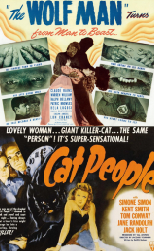 werewolf, was perhaps the first popular reference to the pentagram and silver as symbols and talismans associated with lycanthropy. The 1942 psychological thriller Cat People very strongly asserted the connection between witchcraft, foreign cultures (this time Serbia), transformation (into panthers) , and sexuality (women’s), as the hexed heroine Irena cannot allow herself to become aroused for fear of transmogrification. The transformative process as analogously linked to puberty, the sexualisation of the transformed product as a source of lust, and the ability to transform as that of the underclass, would go on to become themes in romantic, comedic, and dramatic renderings of the werewolf tale, for example in Angela Carter’s erotic short story In the Company of Wolves (1979), coming-of-age comedy Teen Wolf (1985), and the “hillbilly” clan of inbred werepanthers and drug-addicted biker gang of werewolves in Charlaine Harris’ Sookie Stackhouse novels (2001-2013) and Alan Ball’s adaptation for television True Blood (2008-2014). The other-than-human identity community that has formed online and diverged into distinctive subcultures has engaged with, subverted, and re-invented these supernatural archetypes, inscribing them with new meaning.
werewolf, was perhaps the first popular reference to the pentagram and silver as symbols and talismans associated with lycanthropy. The 1942 psychological thriller Cat People very strongly asserted the connection between witchcraft, foreign cultures (this time Serbia), transformation (into panthers) , and sexuality (women’s), as the hexed heroine Irena cannot allow herself to become aroused for fear of transmogrification. The transformative process as analogously linked to puberty, the sexualisation of the transformed product as a source of lust, and the ability to transform as that of the underclass, would go on to become themes in romantic, comedic, and dramatic renderings of the werewolf tale, for example in Angela Carter’s erotic short story In the Company of Wolves (1979), coming-of-age comedy Teen Wolf (1985), and the “hillbilly” clan of inbred werepanthers and drug-addicted biker gang of werewolves in Charlaine Harris’ Sookie Stackhouse novels (2001-2013) and Alan Ball’s adaptation for television True Blood (2008-2014). The other-than-human identity community that has formed online and diverged into distinctive subcultures has engaged with, subverted, and re-invented these supernatural archetypes, inscribing them with new meaning.
In 1992, a newsgroup, alt.horror.werewolves or AHWW, was founded on Usenet for those interested in discussing werewolf-themed fiction, films, and mythologies. From this unexceptional beginning emerged the first known collective of Therianthropes, people who self-identified as superficially human, but animal at their core. The .alt hierarchy of Usenet that AHWW utilised was created for “alternative” topics, those not covered by the mainstream categories. As one of the earliest platforms for online discussion, Usenet bulletin boards quickly became a hotbed for religious dialogue (Helland 2007), and the unmoderated alt. stream hosted threads dedicated to a variety of ‘fringe’ topics and groups, with alt.religion.scientology, alt.pagan, alt.religion.mormon, alt.astrology, alt.paranet.ufo, alt.magick, alt.satanism all featuring in the top twenty most active newsgroups in 1995 (Kinney 1995:769). The preponderance of magic, New Age, and occult thought displayed on Usenet from as early as 1983 is indicative of the entanglement of technology and expressive forms of media with the Pagan and broader metaphysical community (Kinney 1995), a relationship that has been central to the development of these groups at both a general level, and a highly specific one with the Therianthropy movement being a case in point.
Other online avenues were utilised for the expression of other-than-human and interspecies identities, such as mailing lists for discussions and the text-based virtual world game (a MUD or Multi-User Dungeon) FurryMUCK for role-playing, but a major hub for social networking amongst animal-identifying persons at this time was Usenet. The organic outgrowth of a spiritual movement from conversations amongst werewolf fans on AHWW is further a demonstration of the powerful and productive nexus formed of popular culture, metaphysical belief, and the communicative medium of the Internet. Within days of its founding, the subject had turned from recommendations for supernatural fiction to personal accounts of the paranormal, most significantly, with posters claiming to be real life werewolves, vampires, and other types of monsters (Robertson 2013:15). Though initially treated with skepticism, serious engagement with the idea and experience of having an other-than-human identity soon become the central purpose of the newsgroup.
The 1990s saw a continued interest in the werewolf themes heavily featured in the popular culture of the decades prior, with major Hollywood celebrity Jack Nicholson taking on his lycanthrope role in Wolf (1994) and the release of numerous sequels to earlier thrillers like The Howling (1981) and American Werewolf (1981). The 1992 release of White Wolf’s role-play game, Werewolf: The Apocalypse, added an element of environmentalism to the story, with the wolf characters, the loup-garou, being cast as protectors of nature and regular humans as the noxious enemy. This rare casting of the therianthrope as not just sympathetic but heroic can be seen as a turning point for fans of werewolf media. It provided a positive archetype that many in the AHWW community appeared to find validating for their interpretation of the werewolf as a force for good, evidenced by this post on AHWW from 1994: “They [werewolves] represent the possibility of transformation and ascension beyond the norm, and they must deal with both the pleasure and pain attached to this change. They are our hope to be something more than human. Something better” (quoted in Robertson 2013:15).
By the mid-1990s, AHWW was inundated with philosophical, theoretical, and personal conversations about life as a werecreature. Not only wolves, but a tiger, bat, and several windigowak (demonic shapeshifters of the Algonquian peoples ), shared their experiences of entering into an animal state through dreams, meditation, shamanic trance, astral travel, or by sheer accident. Other Usenet groups, like alt.lifestyle.furry and alt.fan.dragon emerged, allowing for the variegation of specialized interests in animals or animal identities (Scribner 2012:5, 40; House of Chimeras 2015). By 1994, the core community and the main tenets of AHWW had been established, evidenced by the dissemination of the first version of their FAQ.
The FAQ unequivocally shows that the purpose of the newsgroup had become the discussion of the spiritual and social reality of other-than-human identities. As one user reminisced, in its nascence, AHWW “was a kind of support group for spiritual therianthropes. There was an attitude of optimism, and it was a gathering place for sober adults to come and talk about feelings and experiences that they had always thought were taboo. It was a time of great acceptance, learning, and an unusual level of maturity” (Yaiolani 1996). The sense of camaraderie felt by main contributors to AHWW was vital to the success of the group, and it allowed them to form strong bonds. As one attested: “although we may be separated by thousands of miles, through the Internet and this newsgroup, we are connected. We become a pack, a virtual family, a collection of individuals with common feelings, ideas and visions. And the loneliness, the aching for contact, is eased just a bit more” (quoted in Robertson 2012:264). In response to this “ache,” in 1994 some of the American members of AHWW arranged the first “Howl” or real life meetup; Europe would have its first in the UK in 1996 (Scribner 2012:40).
A host of terms such as “lycanthrope,” “shifter,” and “were” had been employed to describe being an animal-person, but the overwhelming popularity of wolves made most of the vocabulary lupine-oriented. When a revised FAQ was released in 1995, it became clear that the word of choice was now “therianthrope,” a more encompassing label. This FAQ also clarified the term “Spiritual Therianthropy” as “the ability to mentally transform from the normal human mode of thinking and reacting to an animal one” (AHWW Core-FAQ 1997). A poll of AHWW users was also taken this year, with another in 1997, in the interest of learning more about the common threads that interwove belief in other-than-human identities. The results from 1997 showed a similar demographic to the earlier report, with the average age of respondents at twenty-three, more than half were American, almost half were students, seventy-five percent were male and twenty-five percent female, a propensity towards Paganism and magical traditions if religious, and canids followed by big cats were the most common theriotypes. A range of other animals (like bears, dolphins, birds) and types of mythical creature (like the phoenix and dragon), being represented in minor amounts (Utlah 1997). In the service of such record keeping, in 1995 a system of biographical “WereCards” was introduced, supplying users with a template they could fill in, detailing their Therian identity, which would be lodged in a database for others to read (Utlah n.d.; Scribner 2012:33).
In 1996, the group produced a t-shirt with a design by Therianthrope Jakkal (Jakkal 1999), a clear gesture towards a shared sense 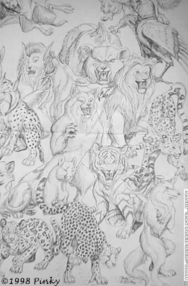 of selfhood. Around this time, The Shapeshifter and Werewolf Handbook also known as The Codex , was put together by Yaiolani with the goal of compiling information about the modern existence of were-creatures, online and off. It detailed a short history of the Therianthropy movement so far (Yaiolani 1996). Yet, as new members joined AHWW, the existing community began to feel fragmented. With increased exposure, came attention from agitators and critics, aiming to mock and derail the discussions of animal-human ontology. To allow for an additional or alternative outlet for discussion, an IRC channel was started, and several members of AHWW began to shift their attentions to chat or mailing lists instead of relying on the newsgroup (Jakkal 1999). A ‘zine called Fang, Claw & Steel (Wessner 1997-2006), was formed for werewolf fans of various levels of devotion and identification who enjoy nuanced werecreature personalities as presented through articles, fan fiction, comics, and artwork.
of selfhood. Around this time, The Shapeshifter and Werewolf Handbook also known as The Codex , was put together by Yaiolani with the goal of compiling information about the modern existence of were-creatures, online and off. It detailed a short history of the Therianthropy movement so far (Yaiolani 1996). Yet, as new members joined AHWW, the existing community began to feel fragmented. With increased exposure, came attention from agitators and critics, aiming to mock and derail the discussions of animal-human ontology. To allow for an additional or alternative outlet for discussion, an IRC channel was started, and several members of AHWW began to shift their attentions to chat or mailing lists instead of relying on the newsgroup (Jakkal 1999). A ‘zine called Fang, Claw & Steel (Wessner 1997-2006), was formed for werewolf fans of various levels of devotion and identification who enjoy nuanced werecreature personalities as presented through articles, fan fiction, comics, and artwork.
A period in 1997, marked as “the winter of discontent,” witnessed the further dissolution of AHWW as discussion devolved into ‘flame wars,’ antagonistic arguments often spurred by outsiders who disbelieved or ridiculed the beliefs of the groups resident Therians (AHWW 1997; Jakkal 1999). As such, Usenet stopped being the home of the Therianthropy community, and a series of other sites were created to foster it, such as WereNet (1999) and Shifters.Org run by Jakkal (2000), and Therianthropy.Org (2000) maintained by Uath and which would host the significant discussion board 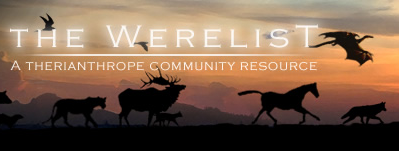 Awereness, and in 2001 The Werelist, another major forum, was opened and administrated by Coyote. The Werelist persists today, and though Awereness is currently defunct rumour on the forums tell of its resurrection in the hope of re-capturing some of the fervor of the halcyon AHWW days. Sites dedicated to specific animal-identities developed, seemingly unaware of the growing Therianthropy movement, like the Unicorn community, stimulated both by Roy Wilkinson’s book Are You A Unicorn? The Mission and Meaning of Unicorns and the website Always Believe by Fadeyr ny h-Emshir which both came about in 1998, though independently (House of Chimeras 2014).
Awereness, and in 2001 The Werelist, another major forum, was opened and administrated by Coyote. The Werelist persists today, and though Awereness is currently defunct rumour on the forums tell of its resurrection in the hope of re-capturing some of the fervor of the halcyon AHWW days. Sites dedicated to specific animal-identities developed, seemingly unaware of the growing Therianthropy movement, like the Unicorn community, stimulated both by Roy Wilkinson’s book Are You A Unicorn? The Mission and Meaning of Unicorns and the website Always Believe by Fadeyr ny h-Emshir which both came about in 1998, though independently (House of Chimeras 2014).
With the new millennium came a proliferation of social networking and individual online platforms. Therians hosted community 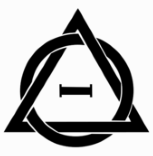 groups and personal pages on LiveJournal, Yahoo Groups, blogs, released educational or personal videos on Therianthropy via YouTube, and today they maintain a significant presence on Tumblr. A symbol, the theta-delta, was developed in 2003 by contributors to The Werelist, and it is displayed by some Therians both on and offline. It is comprised of the Greek letters theta, the first letter of therios, and delta, connoting change; and it is the favicon of the community’s own wiki site (Therian Wikia “Theta Delta” n.d.). It is unknown when the Therianthropy community became as tightly associated with the Otherkin community as it is today. The communities have much overlap online, and, in 2000, a party at the fandom event DragonCon was said to have brought together animal, supernatural, and vampire-identifying people for a “peaceful and productive real life meeting,” according to Van Zandt (2010). Dragons, like Unicorns and other fantastic beasts, provide an obvious link between the two groups, but like other ontologies associated with the other-than-human movement, such as blood-drinking and energy-draining Vampires, they generated their own subcultures.
groups and personal pages on LiveJournal, Yahoo Groups, blogs, released educational or personal videos on Therianthropy via YouTube, and today they maintain a significant presence on Tumblr. A symbol, the theta-delta, was developed in 2003 by contributors to The Werelist, and it is displayed by some Therians both on and offline. It is comprised of the Greek letters theta, the first letter of therios, and delta, connoting change; and it is the favicon of the community’s own wiki site (Therian Wikia “Theta Delta” n.d.). It is unknown when the Therianthropy community became as tightly associated with the Otherkin community as it is today. The communities have much overlap online, and, in 2000, a party at the fandom event DragonCon was said to have brought together animal, supernatural, and vampire-identifying people for a “peaceful and productive real life meeting,” according to Van Zandt (2010). Dragons, like Unicorns and other fantastic beasts, provide an obvious link between the two groups, but like other ontologies associated with the other-than-human movement, such as blood-drinking and energy-draining Vampires, they generated their own subcultures.
Though a great number of books from Pagan authors have been written on the topic of magic using animal parts, deities, spirits, and totems, very few expressly discuss identifying as animals. In 2000, Rosalyn Greene published The Magic of Shapeshifting , which detailed many of the experiences felt by Therians. It was, however, the source of much controversy: the author rehashed discussions held within the online Therian community (though without using the word Therian, instead using the term “shifter,” which had fallen out of favour), but without ever citing these sources (House of Chimeras 2015). Furthermore, she promoted techniques for physical shifting, that is, full transformation from a human into an animal, which many Therians lamentably argue is an impossibility, and a claim they wish to distance themselves from. Lupa, a Pagan author and, at the time, an influential wolf Therian, wrote first about Therianthropy blatantly in Fang and Fur, Blood and Bone (2006) and extended the discussion to the broader other-than-human movement in A Field Guide to Otherkin (2007), drawing upon her experiences in the community and extensive surveys an interviews with members. Her popularity and transparency made these works far more acceptable and respected by Therians than Greene’s earlier coverage.
To further educate the general public about Therianthropy, several well-known Therians have featured in documentaries. For example, Coyote, creator of The Werelist, was interviewed for the program Weird, True and Freaky: Humanimals for the Animal Planet channel in 2008, and Shiro Ulv, founder of the now defunct WulfHowl forum, was featured in I Think I’m An Animal (2013). Therians and Otherkin more broadly have been the subject of several news articles in the last decade, many of which are listed online (AnOtherWiki 2013) and the earliest a piece for The Village Voice called “Elven Like Me” from 2001. Academic articles dedicated exclusively to the Therianthropy community have come from the disciplines of religious studies (Robertson 2012; Robertson 2013), psychology (Grivell et al 2014), and interdisciplinary groups that consist of scholars and Therians. For example, the Therianthropy Research Group (Grivell et al 2014-2015) and the Anthropomorphic Research Project Team (Gerbasi, Kathleen et al. 2011-2015) collect data from the community. The community itself is adept at cataloguing the history and modern subculture of Therianthropy, well demonstrated by timelines and resources produced by Wolf Van Zandt, House of Chimeras, and Orion Scribner.
DOCTRINE/BELIEFS
There are no prescribed beliefs, ideologies, or practices in the Therianthropy community, and its members demonstrate a variety of attitudes and approaches to religion. Spirituality has been a key element in the development of the movement since its inception on AHWW, and as it was explained in the 1995 FAQ, is frequently an essential part of Therian identity: “We who believe in Spiritual Therianthropy … are in-between, half animal and half human in psyche—mental, or spiritual, shapechangers” (Core-FAQ 1997). However, there is a strong sentiment of “spiritual, but not religious” amongst many Therians, at least with regard to how Therianthropy itself should be understood. While the experience may be spiritual and have spiritual applications, many are firm that this does not mean the community should be seen as a religion or “cult.” The introductory page of the Therian Wilderness Forum makes clear this position: “Therian Wilderness is a community dedicated to separating the real views of Otherkin and Therianthropy, spiritual and otherwise, from the unrealistic ideas that have accumulated around the sub-culture. “Spiritual does not mean “Religious” and we are not a religion, although many of our members do have separate religious beliefs” (“About This Forum” n.d.). Previously, the Therian Wilderness homepage carried a banner saying “We are not Human Beings on a Spiritual Journey, We are Spiritual Beings on a Human Journey.” It is possible that its removal was to further emphasise that the forum in no way wished to be seen as a “religious” structure.
Having an animal-human identity is the singular shared characteristic that binds Therians together, though they may have differing explanations for and experiences of it, spiritual or otherwise. Some Therians feel that their animal and human sides are quite distinct, whereas others consider themselves to be at all times an immutable blend. Important to this interspecies being, regardless of the level of integration, seems to be the symbolic, though sometimes spiritual, physical, and lived, liminality (Robertson 2013:22-23). As this Therian attests in their definition of what it means to be a Therianthrope, the liminal aspect is central: “Fundamentally, it means that you in some way perceive yourself as occupying the liminal space between human (anthropos) and wild animal (therion). You may believe yourself to be a human who identifies with a wild animal, or a wild animal soul in a human body, or any of a number of variants—the key concept is the liminality, the between-ness of human and non-human animal” (Lynx Canadensis 1999). Being a Therianthrope is additionally defined by what it is not , demonstrated in this definition supplied by Orion Scribner: “Therianthropes identify as animals. A Therianthrope’s animal self is his or her self. His or her animal self isn’t an outside animal spirit guide or totem, isn’t a game of pretend or a role-playing character, and isn’t merely a favorite animal” (2013:31).
While the aetiology of one’s Therianthropy can be attributed to either a scientific or a spiritual cause, it is understood definitively to be an internal experience, not influenced by external factors or entities. Some Therians may consider their identity to have neurological or psychological origin, but there is a general rejection of the pathologisation of this phenomenon. There is an intentional distancing from clinical lycanthropy, a rare delusion of being an animal, usually a wolf, which can manifest in animalistic behaviour such as biting, scratching or barking. There is, however, some preference in the wider other-than-human community for an acceptance of individuals who host more than one identity, which can be of varied gender, species, and personality. Such persons are called “multiples.”, but the negative connotations of psychiatric terms like “disorder,” “illness,” or “dissociative” are eschewed (Lupa 2007:76-79). The most common language used to explain Therianthropy is metaphysical, for example, involving reincarnation, nonhuman souls, and/or a magical connection to the animal world.
A large proportion of Therians identify as Pagans or practitioners of magic, which, considering the major role animals play in nature religions and the indigenous traditions and ancient myths that they draw upon, is not surprising. For some Pagan Therians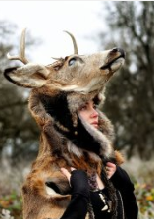 their interspecies identity is a boon for their spell-craft, demonstrated by the blended approach of Lupa’s practice, “therioshamanism” (2008-2014). Symbiotically, a magical outlook can provide those with other-than-human selves a discourse, belief system, and practical techniques such as astral projection, totem invocation, or entering ecstatic and trance states, that may enable them to explore the experience of having a “beast within.” There are Therians who have no religion or are avowed atheists, as well as those who adhere to more “mainstream” religions, such as Christianity. A common concern expressed by Christian Therians is the doctrine of human exceptionalism, which complicates their experience of having a nonhuman soul. Interviews conducted by researchers from the University of Northampton show that in some cases this cognitive dissonance can push an individual to change faiths, in this case from Catholicism to Paganism, to find one more amenable to a Therianthropic identity (Grivell et al. 2014:120).
their interspecies identity is a boon for their spell-craft, demonstrated by the blended approach of Lupa’s practice, “therioshamanism” (2008-2014). Symbiotically, a magical outlook can provide those with other-than-human selves a discourse, belief system, and practical techniques such as astral projection, totem invocation, or entering ecstatic and trance states, that may enable them to explore the experience of having a “beast within.” There are Therians who have no religion or are avowed atheists, as well as those who adhere to more “mainstream” religions, such as Christianity. A common concern expressed by Christian Therians is the doctrine of human exceptionalism, which complicates their experience of having a nonhuman soul. Interviews conducted by researchers from the University of Northampton show that in some cases this cognitive dissonance can push an individual to change faiths, in this case from Catholicism to Paganism, to find one more amenable to a Therianthropic identity (Grivell et al. 2014:120).
Determining one’s theriotype can be an inborn knowledge, a moment of intuition, or, conversely, an ongoing project of actualization according to most 101-style guides produced by Therians on the subject (for example, see “Discovery” at Therian Guide n.d.). As in the Otherkin community, Therians sometimes use the word “Awakening” to describe this revelatory process. Recommended methods for self-discovery include introspection, meditation, trance states, prayer and guidance from the spirits or gods, and researching animal behaviours, habitats and physical features to recognise patterns within one’s own life. While the community can be a helpful resource for learning more about animal identities, it is frequently insisted that, ultimately, each Therian’s understanding of their own Therianthropy is reliant on “unverified personal gnosis” (Robertson 2013:19).
The community has devised an ample lexicon for different types of Therian based on their animal kind and the level of 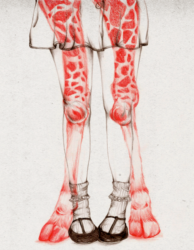 amalgamation with their human persona. Sites and documents like Therianthropes United or Scribner’s “Lexicon” (2013) provide extensive glossaries of the relevant neologisms, phrases and terms. As “Lycanthrope” is used to describe a wolf Therian, the terms “Cynanthrope” and “Ailuranthrope” mean dog and cat Therian respectively. A “Cladotherian” has a therioside that is not specific to any breed, but encompasses a broader genus or species. “Polyweres” are Therians with multiple but separate animal types, and “Polymorphs” have theriosides that are composite creatures. “Contherianthropy” is used to describe having one’s human and animal side fully and constantly integrated; alternatively, a Therian will “shift” between their human and animal mindsets.
amalgamation with their human persona. Sites and documents like Therianthropes United or Scribner’s “Lexicon” (2013) provide extensive glossaries of the relevant neologisms, phrases and terms. As “Lycanthrope” is used to describe a wolf Therian, the terms “Cynanthrope” and “Ailuranthrope” mean dog and cat Therian respectively. A “Cladotherian” has a therioside that is not specific to any breed, but encompasses a broader genus or species. “Polyweres” are Therians with multiple but separate animal types, and “Polymorphs” have theriosides that are composite creatures. “Contherianthropy” is used to describe having one’s human and animal side fully and constantly integrated; alternatively, a Therian will “shift” between their human and animal mindsets.
“Shifts” are reported by Therians in a variety of forms and using differing terminology. This can include astral shifts, dream shifts, etheric shifts, bi-location shifts, amongst others. However, there are three core types of shift central to Therian discourse and experience: mental or m-shifts, phantom or ph-shifts, and physical or p-shifts. A mental shift, which may be brought on intentionally or triggered by surprise, strong emotions, or other stimuli, will cause the Therian to assume the mental state of their therioside. Consequently, a Therian might begin to think, act, or react in an “animalistic” way. This is one of the most indicative and common “symptoms” of Therianthropy. A phantom shift is typically invoked by a mental shift. In this case, the body parts of the therioside are felt or sensed by a Therian, for example, a tail, set of wings, claws, in the way a phantom limb may be felt by an amputee. Some explanations of phantom shifts rely on esoteric notions of astral, aural, or etheric planes of existence and subtle body discourses, others are neurological.
Finally, a physical shift, transforming bodily and biologically from a human into an animal, has been an essential ingredient in 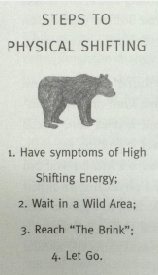 many therianthropic myths. However, in the modern Therianthropy community this subject is widely considered taboo. While a range of spiritual explanations and beliefs regarding Therianthropy are tolerated, shared, and encouraged, physical shapeshifting is regarded variously as the stuff of legend, a scientific impossibility, a potentially damaging claim, and an idiotic belief. As expressed by Jakkal in an orientation post for new users of Werelist, belief in p-shifting is often the source of ridicule inside and outside the community: “Every person that claims they can physically shapeshift is a poser … They cannot change into animals. But they really want you to believe it because they love the attention” (Jakkal 2014). Nevertheless, physical shifting remains a consistent subject of discussion outside of forums that seek to prohibit it, like The Werelist and The Therian Guide.
many therianthropic myths. However, in the modern Therianthropy community this subject is widely considered taboo. While a range of spiritual explanations and beliefs regarding Therianthropy are tolerated, shared, and encouraged, physical shapeshifting is regarded variously as the stuff of legend, a scientific impossibility, a potentially damaging claim, and an idiotic belief. As expressed by Jakkal in an orientation post for new users of Werelist, belief in p-shifting is often the source of ridicule inside and outside the community: “Every person that claims they can physically shapeshift is a poser … They cannot change into animals. But they really want you to believe it because they love the attention” (Jakkal 2014). Nevertheless, physical shifting remains a consistent subject of discussion outside of forums that seek to prohibit it, like The Werelist and The Therian Guide.
ORGANIZATION/LEADERSHIP
The Therianthropy movement generally flouts formal, dogmatic structures, and it professes no
doctrine or sacred texts, involves no mandatory initiation rites or rituals, and has no founder or officially recognised class of experts. Nonetheless, power and influence are implicitly wielded, mostly through the structures inherent in community-building online. Through moderating topics and users on forums, disseminating certain essays, glossaries, FAQs, and interpretations, and creating engaging and convincing content that gets shared prolifically and absorbed, a normative version of Therianthropy is produced and accepted (Robertson 2014). Interestingly, collaborative spaces, such as forums, are frequently adamant that there is no social hierarchy in the community and reject the validity of stratified groups, such as “packs” that are lead by “alphas.” Trying to “pull rank” on forums like The Werelist or Therian Wilderness can result in a ban, itself an assertion of authority. Though Therians who participate in media reports may appear as spokespersons for the community, this not a communal decision. The term “grey muzzles” is sometimes used to describe members of the community who have been significant contributors since the time of AHWW, and, as this title indicates, they may be treated as “elders” and holders of wisdom based on their years of experience. How tensions related to the ambiguities of this power structure and the resultant “Therian elitism” (RedFeatherFalconHawk 2011) can play out will be discussed in the following section.
ISSUES/CHALLENGES
As with the related subculture of Otherkin, most of the challenges for the Therianthropy community stem from issues of authenticity and authority. Amongst Therians this tension manifests largely in the splintering of the community as new forums are established for Therians who want to focus their discussions around certain shared ideas and interests. Reflecting on the reasons some Therians left or were disinclined to contribute to forums, one person remarked that they did not feel safe or supported: “they didn’t want to go through this hassle of always having to ‘prove’ the legitimacy of their experiences. Many have gone offline now, or moved to blogging or other ways to express themselves” (Akhila 2012). Personal pages as a platform to inform and share experiences of Therianthropy have been steadily increasing in number, and while many are open to comments from readers and the public, they are under the control of the author.
Wariness of intimations of superiority or dogmatism from members is a constant, and not only concerning community-based platforms. In 2006, possibly the first and only attempt at recruiting Therians for a religion was made by the founder of the “Therian Temple,” which the Therian Wikia describes as “the most infamous and controversial group within the Therian community” (Therian Wikia “Therian Temple” n.d.). The Temple was modelled after a Western esoteric lodge format, and though it used a mix of ceremonial magic and Christian terminology it was categorically aiming to be an occult order for the practice of “Therian magic.” Joining involved paid registration that covered their sacred text, The Therian Bible , and the taking of the “Oath of Therion” during which a member would pledge to uphold the “Therian Code.” Wolf Van Zandt comments that it was immediately unpopular because Therians are generally reticent to label Therianthropy a religion, the Code required vegetarianism of its converts, and Therians “tend to be rather anarchic and resent being told how they should live their lives” (n.d.). Despite the level of vitriol with which it was met, the Temple was a minor movement that seemed to gain few initiates and has long since abandoned its web pages.
Like most other-than-human identity groups, the harmony of the Therian community is affected by exposure to critics and skeptics who argue against the possibility and reality of their unusual ontological position. This can make Therians both reluctant 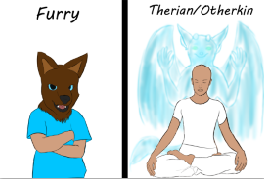 to post online about their personal lives for fear of being “outed” to family and friends and disinclined to speak to media outlets and researchers. They have been the subject of ridicule online, evidenced by a meme called FYIAD or “Fuck you, I’m a Dragon,” a phrase that is meant to encompass the defensive logic of having a nonhuman identity in a human body (Know Your Meme n.d.). The need to emphasise that Therianthropy is either a mental or metaphysical position rather than a sign of insanity, a joke, or a form of roleplay also appears constant, particularly when conflated with the Furry community, which receives its own share of derision. Challenges to legitimacy can also come from within the community, and these can be incidental rather than intentional. For example, Lupa, an influential neo-Pagan who produced numerous works on Otherkin, Therianthropy, and relevant spiritual matters and methods while identifying as a wolf Therian, has since concluded that she is not a Therian (2013). This admission on her personal page was confronting for some of her fans and once-fellow Therians. This is evidenced by comments left on her post expressing sadness and disappointment in the loss of such a prominent community figure whose writings and ideas had given others credence for beliefs that elsewhere would be disregarded as unorthodox or insane. While Lupa stated clearly that her decision to disassociate from this identity label was not a comment on its validity for others, her revelation likely reflects the struggle with doubts that many Therians experience.
to post online about their personal lives for fear of being “outed” to family and friends and disinclined to speak to media outlets and researchers. They have been the subject of ridicule online, evidenced by a meme called FYIAD or “Fuck you, I’m a Dragon,” a phrase that is meant to encompass the defensive logic of having a nonhuman identity in a human body (Know Your Meme n.d.). The need to emphasise that Therianthropy is either a mental or metaphysical position rather than a sign of insanity, a joke, or a form of roleplay also appears constant, particularly when conflated with the Furry community, which receives its own share of derision. Challenges to legitimacy can also come from within the community, and these can be incidental rather than intentional. For example, Lupa, an influential neo-Pagan who produced numerous works on Otherkin, Therianthropy, and relevant spiritual matters and methods while identifying as a wolf Therian, has since concluded that she is not a Therian (2013). This admission on her personal page was confronting for some of her fans and once-fellow Therians. This is evidenced by comments left on her post expressing sadness and disappointment in the loss of such a prominent community figure whose writings and ideas had given others credence for beliefs that elsewhere would be disregarded as unorthodox or insane. While Lupa stated clearly that her decision to disassociate from this identity label was not a comment on its validity for others, her revelation likely reflects the struggle with doubts that many Therians experience.
**Images
Founder/Group History Section
Image #1: The löwenmensch, a lion-headed-human figure of Hohlenstein-Stadel from the Aurignacian period (first paragraph).
Image #2: Furries in fursuits at MidWest FurFest 2008. Photo by Laurence Parry (second paragraph).
Image #3: Posters for the films Wolf Man and Cat People (paragraph 4).
Image #4: Unicorns United by Roy Wilkinson (paragraph 12)
Image #5: Banner for The Werelist forum (between paragraph 12-13).
Image #6: The Theta-Delta symbol (paragraph 13).
Doctrines/Beliefs Section
Image #7: Deer-skin headdress by NaturePunk (paragraph 4)
Image#8: Giraffe girl from Peony Yip’s ‘Transformation’ series (paragraph 6)
Image #9: P-shifting from Greene (paragraph 8)
Issue/Challenges
Image#10: Furry vs Therian/Otherkin image by DeVoutNumelran (paragraph 3)
REFERENCES
“About This Forum.” n.d. Therian Wilderness. Accessed from http://therian-wilderness.proboards.com/ on 6 October 2015.
AHWW. 1997. “Core-FAQ.” Alt.horror.werewolves. Archived by Utrecht University at http://faqs.cs.uu.nl/na-dir/werewolves/core-faq.html. Accessed on 6 October 2015.
Akhila. 2012. “Norms, Short Term History and the Collective Memory.” Thébaïde. Accessed from http://akhila.feralscribes.org/2012/norms-short-term-history-and-the-collective-memory/ on 6 October 2015.
Bourgault du Coudray. 2006. The Cure of the Werewolf: Fantasy, Horror and the Beast Within. London: IB Tauris.
“Discovery.” n.d. Therian Guide. Accessed from http://www.therian-guide.com/index.php/3-discovery.html on 6 October 2015.
Gerbasi, Kathleen et al. 2011-2015. Anthropomorphic Research Project. Accessed from https://sites.google.com/site/anthropomorphicresearch/home on 6 October 2015.
Gerbasi, Kathy et al. 2008. “Furries from A to Z (Anthropomorphism to Zoomorphism).” Society and Animals 16:197-222.
Grivell, Timothy, Helen Clegg, and Elizabeth C. Roxburgh. 2014. “An Interpretative Phenomenological Analysis of Identity in the Therian Community.” Identity: An International Journal of Theory and Research 14:113-135.
Grivell, Timothy et al. 2014-2015. Therianthropy Research Group. Accessed from http://therianthropyresearchgroup.weebly.com/ on 6 October 2015.
Helland, Christopher. 2007. “Diaspora on the Electronic Frontier: Developing Virtual Connections with Sacred Homelands.” Journal of Computer-Mediated Communication 12:956–76.
House of Chimeras. 2015. “A History of the Draconic Community – 1993 to 2000.” Between Forest and Sea. Accessed from http://houseofchimeras.weebly.com/history-of-the-draconic-community—1993-to-2000.html on 6 October 2015.
House of Chimeras. 2014. “A History of the Unicorn Community.” Between Forest and Sea. Accessed from http://houseofchimeras.weebly.com/a-history-of-the-unicorn-community.html on 6 October 2015.
Jakkal. 2014. “So Your Pack Can P-Shift.” The Werelist. Accessed from http://www.werelist.net/showthread.php?33923-So-your-pack-can-P-shift on 6 October 2015.
Jakkal. 1999. “ Foundation’s Edge: The History of the Online Werecommunity.” WereNet. Archived at http://web.archive.org/web/20010620111439/http://www.were.net/foundation.shtml accessed on 6 October 2015.
Kinney, Jay. 1995. “Net Worth? Religion, Cybersapce, and the Future.” Futures 27:763-76.
Kirby, Danielle. 2013. Fantasy and Belief: Alternative Religion, Popular Narratives, and Digital Cultures. Sheffield: Equinox.
“ F*ck you! I’m a Dragon!” 2014. Know Your Meme. Accessed from http://knowyourmeme.com/memes/fck-you-im-a-dragon on 6 October 2015.
“ List of Otherkin Media Appearances.” 2013. AnOtherWiki. Accessed from http://anotherwiki.org/wiki/List_of_Otherkin_Media_Appearances on 6 October.
Lupa. 2013. “ Letting Go of Therianthropy For Good.” Therioshamanism. Accessed from http://therioshamanism.com/2013/04/02/letting-go-of-therianthropy-for-good/ on 6 October.
Lupa 2008-2014. “About Therioshamanism.” Therioshamanism. Accessed from http://therioshamanism.com/about/#whatis on 6 October.
Lupa. 2007. A Fieldguide to Otherkin. Stafford: Megalithica.
Lupa. 2006. Fang and Fur, Blood and Bone. Stafford: Megalithica.
Lynx Canadensis. 1999. “ What Does It Mean to Be a Were—and Is Were the Word to Use?” Wild Ideas: An Online Exploration of the Wild. Accessed from http://www.wildideas.net/temple/library/letters/weremeaning.html on 6 October 2015.
Mamatas, Nick. 2001. “Elven Like Me.” The Village Voice. Accessed from http://www.villagevoice.com/news/elven-like-me-6416536 on 6 October 2015.
RedFeatherFalconHawk. 2011. “Therian elitism.” DeviantArt. Accessed from http://redfeatherfalconhawk.deviantart.com/journal/Therian-Elitism-Something-That-Needs-to-be-Said-221149306 on 6 October 2015.
Robertson, Venetia. 2014. “The Law of the Jungle: Self and Community in the Online Therianthropy Movement.” The Pomegranate: The International Journal of Pagan Studies 14:256-80.
Robertson, Venetia. 2013. “The Beast Within: Anthrozoomorphic Identity and Alternative Spirituality in the Online Therianthropy Movement.” Nova Religio 16:7-30.
Scribner, Orion. 2013. “ Otherkin Lexicon: A Multi-lingual Dictionary of Jargon Used in the Communities of Otherkin, Therianthropes, and Other Similar eoples, v. 0.1.” The Art and Writing of O. Scribner. Accessed from http://orion.kitsunet.net/nonfic.html on 6 October 2015.
Scribner, Orion. 2012. “ Otherkin Timeline: The Recent History of Elfin, Fae, and Animal People, v. 2.0.” The Art and Writing of O. Scribner. Accessed from http://frameacloud.com/wp-content/uploads/2015/01/Scribner_Timeline2p0.pdf on 6 October 2015.
“Therian Temple.” n.d. Therian Wikia. Accessed from http://therian.wikia.com/wiki/Therian_Temple on 6 October 2015.
Therianthropes United. n.d. Accessed from http://www.therianthropes.com/shapeshifters_definition.htm on 6 October 2015.
“Theta-Delta.” n.d. Therian Wikia. Accessed from http://therian.wikia.com/wiki/Theta-Delta on 6 October 2015.
Utlah. 1997. “The AHWW Poll”. WereWeb. Archived at https://web.archive.org/web/20010209042029/http://www.swampfox.demon.co.uk/utlah/index2.html on 6 October 2015.
Utlah. n.d. “Werecard Archive.” WereWeb. Archived at https://web.archive.org/web/20010209042029/http://www.swampfox.demon.co.uk/utlah/index2.html. Accessed on 6 October 2015.
Van Zandt, Wolf. (2010). The Therian Timeline. Accessed from http://theriantimeline.com/the_timeline on 6 October 2015.
Van Zandt, Wolf. n.d. “ Religion and Weres.” The Therian Timeline. Accessed from http://www.theriantimeline.com/religion_and_weres on 6 October 2015.
Wessner, Terry. 1997-2006. Fang, Claw & Steel: A Lycanthrope Review. Accessed from http://webhome.idirect.com/~twessner/fcs/fcs.htm on 6 October 2015.
Wilkinson, Roy. 1998. Are You A Unicorn? The Mission and Meaning of Unicorns. Kaysville, UT: Unicorns United.
Yaiolani. 1996. T he Werewolf and Shapeshifter Codex: Everything You Ever Wanted to Know About Werewolves, but Were Afraid to Ask. Archived at http://web.archive.org/web/20090930054354/http://yaiolani.tripod.com/handbook.htm. Accessed on 6 October 2015.
Publication Date:
11 October 2015
